Ablain St-Nazaire French Military Cemetery “Notre Dame de Lorette”, France
Ablain St.-Nazaire French Military Cemetery, also known as “Notre Dame de Lorette”, is the largest French military cemetery in the world.
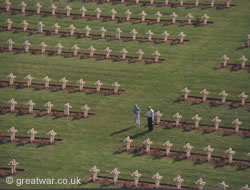
|
A total of 40,057 casualties are buried here. Almost all of the remains are casualties of the First World War. Burials also include 6 French graves from the Second World War, an unknown soldier of the French-Indochina conflict of 1945-1954 and an unknown soldier of the French-North African conflict of 1952-1962. There are burials of the remains of 64 Russians, 1 Belgian and 1 Romanian.
First World War Burials
The First World War French military burials in this cemetery total 39,985.
Ossuaries
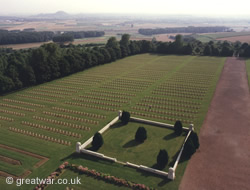
|
The total number of First World War military burials includes the remains of 19,998 First World War casualties who are laid to rest in seven ossuaries in the cemetery grounds. These seven ossuaries contain the remains of French servicemen brought into the cemetery from the Artois battlefields including single burials, burials in civilian cemeteries and small military burial sites within a radius of some 30 miles of Ablain St. Nazaire. The ossuaries are named after military commanders.
Ossuaries Number 1 - 5 are located at the western end of the cemetery.
- Ossuary No. 1 Fayolle: 1,006 bodies
- Ossuary No. 2 Franchet d'Esperey: 1,892 bodies
- Ossuary No. 3 Joffre: 1,874 bodies
- Ossuary No. 4 Lyautey: 957 bodies
- Ossuary No. 5 Pétain: 1,029 bodies
Numbers 3 bis and 4 bis are situated on the eastern side of the Lantern Tower.
- Ossuary No. 3 bis Foch: 4,563 bodies
- Ossuary No. 4 bis Barbot: 5,649 bodies
At the base of the Lantern Tower an eighth ossuary-crypt contains the remains of another 6,000 soldiers.
Muslim Graves
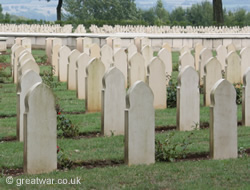
|
There is a plot at the western end of the cemetery for muslim soldiers, and each grave has a headstone instead of a cross. Each headstone is positioned so that it faces east. North Africans from the 1st Moroccan Division fought in this area during the battles of 1915 for the ridges of Notre Dame de Lorette and Vimy.
General Barbot
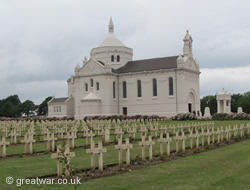
|
General Ernest Barbot is buried in the cemetery. He was commander of the French 77th Mountain Division and he was killed on the Artois battlefield at Souchez on 10th May 1915. The division had fought in the first battles of the war in the Alsace mountains and had been moved to Artois by early 1915. The grave marker was originally one created by his soldiers as a cross made out of shell casings. That cross was stolen in 1952 and was replaced with the same simple cross that marks the final resting place of so many of General Barbot's comrades in arms.(1)
Battlefield of Lorette

The Battle of Lorette took place between the German and the French Armies for the best part of a year, between October 1914 and October 1915. The ridge of high ground rises to 500 feet (165 metres) and as a dominant feature in the landscape, the views from the summit were crucial to occupy. The fighting for possession of the ridge cost many thousands of casualties on both sides.
Chapel of “Notre Dame de Lorette”
The English translation of “Notre Dame de Lorette” means “Our Lady of Lorette”, namely the Our Lady, the Virgin Mary of Lorette. The association of this hill in northern France with the Virgin Mary and the name of Loreto (Lorette) originates from the 18th century.
A Miraculous Cure in Loreto
According to local history, a man from the village of Ablain St. Nazaire, a painter called Florent Guilbert, had a medical problem with one of his legs. He went on a pilgrimage to the holy site of the House of Loreto in central Italy in 1727.
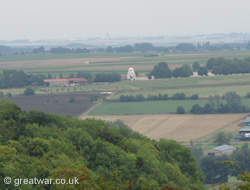
|
This was the “Holy House of Loreto ” (the “Santa Casa di Loreto”)(2). It was said to be the original house of the Virgin Mary in which she had grown up and had been visited by the angel to tell her she would give birth to Jesus. The house had been moved from Nazareth for fear of its destruction in 1291 and by the time of Guilbert's visit would have been in its third location on the eastern Italian Adriatic coast near Recanati.
The name of Loreto frequently being associated with the Virgin Mary from that time, and hence the name of the “House of Our Lady of Loreto”, is believed to have orginated from the latin word “lauretum” for the laurel trees which were in the Italian location where the house ended up, or it may have been taken from the name of the owner of the land who was called “Laureta”.
The “Holy House of Loreto” had become a shrine to the Virgin Mary, where miracles had taken place and so pilgrims visited to pray for cures and miracles. Florent Guilbert's leg was, according to the story, miraculously cured. He returned from Italy to his home in France at Ablain St. Nazaire with a statue of the Virgin Mary.
A Private Chapel on the Ridge
On the ridge overlooking his village he built a small private chapel or shrine as a place of prayer to house the statue and give thanks for his cure. From that time, about 1729, people who heard of his cure also travelled to Guilbert's small chapel in pilgrimage to pray to the Virgin Mary. The original chapel was destroyed in 1794. It was built again in the year 1815.
Over the years the site on top of the hill overlooking Ablain St. Nazaire became established as a place of pilgrimage between 1870-1880 and other chapels were located there too. Abbot Victrice Pingrenon looked after the site at about this time.
By the time of the First World War there was a small chapel standing on the original location of Guilbert's first shrine to the Virgin Mary. This was destroyed during the battles to secure the hill between the French and German Armies in early 1915. A stele (marker) on the ground just inside the main entrance to the cemetery marks the place where Guilbert's original chapel stood.
The Modern Chapel of Notre Dame de Lorette
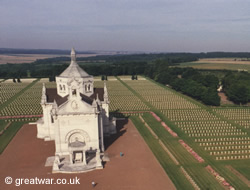
|
The modern chapel was built in the centre of the military cemetery and takes its roots from Guilbert's 18th century chapel on the hill. The first stone for the building of the new chapel after the 1914-1918 war was laid by Monseigneur Julien on 19th June 1921. The chapel was consecrated in a service on 5th September 1937 by Monseigneur Dutoit.
The building retained the name of a chapel even though it is quite a grand structure in the Romano-Byzantine style. The structure is made of a cement frame with Givet stone facing. The altar of the chapel is located outside the building at the entrance to the east door. The Notre Dame de Lorette statue of the Virgin Mary with Jesus stands next to the main altar inside the chapel.
The chaplain of the chapel holds a service of Mass at 11 o'clock each Sunday from May to 11th November.
First Chaplain of Notre Dame de Lorette Chapel
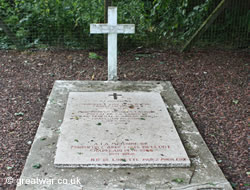
|
The grave of Léon Briche (1884-1936), the first Chaplain from 1931-1936 of the chapel of Notre Dame de Lorette in the military cemetery, is situated in the trees close to the eastern boundary of the French National Military Cemetery.
The Lantern Tower
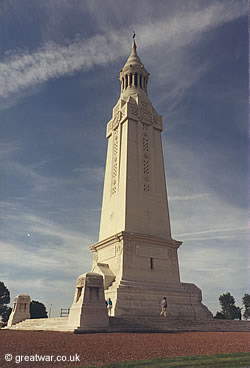
|
The architect Louis Cordonnier designed the Lantern Tower. The first stone for the Lantern Tower was laid on 19th June 1921 by Maréchal Pétain. The inauguration ceremony was held on 2nd August 1925.
The tower is 150 feet (52 metres) high with 200 steps. Until recently the tower was open to the public to climb to the stop, but the viewing area at the top has been closed for reasons of security.
The base of the tower is a square with each side being 35 feet long.
The Beacon of Light
After dark the beacon from the Lantern Tower revolves five times each minute. The ray of light from the beacon covers a distance of about 45 miles (70 kilometres).
Ossuary and Chapel of Rest
At the base of the tower there is an ossuary-crypt containing the remains of 6,000 soldiers and a Chapel of Rest. There are 32 coffins located in the Chapel of Rest in four groups of 8 coffins. Three coffins contain the remains of an unknown soldier from the Second World War (laid to rest here in July 1950), a soldier from the North African war (laid to rest here in October 1977) and the remains of a soldier from the Indochine war (laid to rest here in June 1980).
A reliquary (a container for relics) was placed in the tower in April 1955, which contains soil and ashes from the concentration camps of World War II.
Association of Notre Dame de Lorette Monument
The Association was founded in 1920. It's aim is to help to keep the memory of the dead of all wars and also to be involved with the upkeep of the cemetery and assist with access and information for visitors. There are over 3,000 members who include founder members, associated members and “Honour Guards”.
Honour Guards
The Honour Guards are volunteers who retain the memory of those who died for France. They are representatives of the families of the dead who are known to the buried in the cemetery. Each day of the year between Palm Sunday to Remembrance Day on 11th November the Honour Guards stand guard at the ossuary. Each Sunday in that period also, at 11.45 am the “Souvenir Flame” in the centre of the cemetery is rekindled by the leader of the guards on duty that day.
Information
For information regarding the cemetery contact:
Secretariat d l'Association du Monument de Notre Dame de Lorette, 62153 Ablain Saint Nazaire, France.
Location
Access and Parking
There is ample free parking for cars and coaches at the cemetery site.
Toilets
There are public toilets near the south entrance to the cemetery, but they may not be open or in use. There is a restaurant on the north side of the cemetery, but visitors are advised that the toilet facilities there are for clients of the restaurant only.
Related Topic
Canadian National Vimy Memorial, Vimy Ridge
In 1915 the French Army carried out two offensives to try to push the Germans off the high ground of the Vimy Ridge, which lies to the east of Notre Dame de Lorette. In the spring of 1917 British units and the Canadian Corps took part in the Allied offensive called the Battles of Arras (9 April to 4 May 1917). A national memorial to Canada's forces who fought in the Great War of 1914-1918 is located on that highest piece of ground on the ridge.
Canadian National Vimy Memorial
Acknowledgements
(1) Information with grateful thanks to Memoires de Pierre: Souchez
(2) Website: www.loretohouse.org/the-loreto-house-story/

